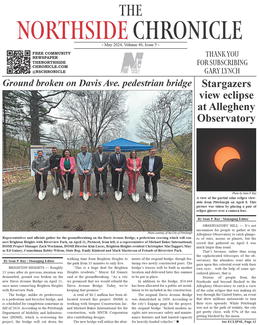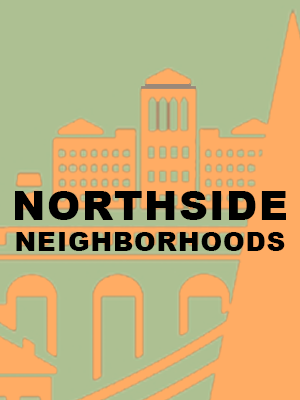Dangerous intersection yet to be addressed by city
Normal.dotm
0
0
1
1172
6685
The Northside Chronicle
55
13
8209
12.0
0
false
18 pt
18 pt
0
0
false
false
false
/* Style Definitions */
table.MsoNormalTable
{mso-style-name:”Table Normal”;
mso-style-parent:””;
font-size:12.0pt;”Times New Roman”;
mso-fareast-“Times New Roman”;
mso-bidi-“Times New Roman”;}
It would have been an average day for Tatanisha Smith.
A pediatrician at Allegheny General Hospital, she had just ended her shift and was only three blocks into rush hour traffic going east on North Avenue when her green Ford Five Hundred collided with a white sedan at the Middle Street intersection.
The mid-August crash resulted in severe front end damage to Smith’s car, but she didn’t suffer any injuries or suspension damage to her car.
The other driver wasn’t as lucky.
Dwayne Ray escaped bodily harm, but his Mercury Cougar had to be towed away due to what appeared to be a broken front axle.
Any Deutschtown resident will vouch for how difficult it is to make a left at this intersection, which has two lanes of traffic in either direction.
While trying to make a left-handed turn onto Middle St., Ray said he couldn’t see past the line of stopped cars in the outside lane, which were waiting to get onto East Street. As he crossed traffic, Smith’s car emerged from his blind spot in the inside lane. At that point, it was already too late.
This would be an unremarkable event — a predictable consequence of the daily commute in this rush hour world.
It would be, if not for the fact that Deutschtown community members have lobbied the city for alterations to slow down traffic at the Middle and North intersection for years.
Local residents attest that accidents at the intersection are a regular occurrence.
“I see about 8 to 10 [crashes] at that intersection during the school year,” said Sue Friscoe, who works as a crossing guard on East North Avenue.
Friscoe said that number is pretty high, since she only works three hours a day on week days for nine months of the year.
“In the morning, I’ll see broken glass sometimes from [crashes that happened] the previous evening.”
Friscoe has reason to complain. She’s been hit twice by vehicles while directing traffic. Once, a man turned left at Middle Street onto North Avenue and hit her from behind. Another woman’s vehicle brushed up against her while she was helping students climb onto a school bus in the morning.
Records released by PennDOT show only 12 documented crashes at the intersection in the three-and-a-half year span between mid-2005 and the end of 2008.
But Allison Wenger of PennDOT said these were only the “reportable crashes.” The criteria for a reportable crash, which police are instructed to document, are that at least one car needs to be towed from the scene, a person receives serious injuries or property damages occurs.
“If there’s just a fender bender, then police won’t write a report,” Wenger said.
Of the 12 accidents, none reported fatalities. Nearly all reports featured vehicles turning from Middle Street onto North Avenue being hit by traffic along E. North Avenue.
Both PennDOT and Pittsburgh’s Zone 1 police claimed not to have access to 2009 accident files.
Joe Renckley, whose lived nearby for 25 years and has become something of an expert on the intersection, confirmed that he has seen quite a few individuals who crashed into one another at the intersection, simply trade insurance information and then drive off before police come to the scene.
After witnessing the hefty number of crashes at the intersection for years, Renckley decided to put together a petition for a stop sign on North Avenue. After collecting 66 signatures, he took his petition to a meeting with Public Works director Guy Costa and aides from Councilwoman Darlene Harris’s office in January of this year. But what he saw as an obvious necessity for the protection of Northside residents, turned out to be a much more intractable issue than he was expecting.
What residents like Renckley see as a protection for local residents is viewed among city officials as an obstacle to efficient traffic movement.
According to Renckley, Costa told worried residents that there just wasn’t enough traffic on Middle Street to warrant a stop sign on East North Avenue. He and city planners said that the paramount issue was getting rush hour traffic from Allegheny General Hospital and other businesses onto 279 as quickly as possible. During rush hour, traffic congestion can be gridlocked along E. North Avenue between Sandusky Street and 279.
Costa was not able to be reached for this article.
Renckley said that Harris’s now-former aide Ken Minton told him at the time that city engineers were also concerned that stop signs would have the added effect of backing up traffic onto 279 during Steelers or Pirates home games. Minton no longer serves in Harris’s office and was unavailable for comment.
Renckley would rather see a stop light at the intersection, but if a stop sign was already this controversial, he said, a traffic light would be next to impossible. “You just have to beg and plead for the city to do anything, so I’m just trying to do the easiest option.”
But Renckley said he does see room for hope in a plan to narrow North Avenue to two lanes between Cedar Avenue and 279 and convert the current curb lanes into parking.
One of the plan’s lead proponents, Nick Kyriazi of the East Allegheny Community Council, has been pushing this topic with city engineers and politicians for seven years now. The idea is to push traffic away from the residential area along E. North Avenue, not necessarily to increase parking or make the Middle Street intersection safer, although it has both those benefits.
Kyriazi believes that because E. North Avenue is treated like “a barren and dusty access road,” the residentially-zoned area on its flank is more difficult to develop.
The EACC originally proposed the plan after restoring five houses for resale on E. North Avenue in 2002. Kyriazi said the group found it difficult to market the houses, because of their close proximity to the traffic on E. North Avenue.
“You could stand on the doorstep and touch the buses driving by,” Kyriazi said.
In 2002 the city tentatively agreed to an informal three-part plan that called for allowing parking at all times on the north side curb lane and the south side curb lane on weekends. Eventually, the city would convert both curb lanes into permanent parking by adding curb extensions on the corners of each block.
By converting the avenue permanently into two lanes between Cedar Avenue and East Street, this would also take care of the safety issue at the Middle Street intersection, Kyriazi said.
In a reversal of fortunes at a meeting in the summer of 2005, city officials distanced themselves from these goals, saying that the resulting increased congestion was not worth the hassle.
Costa cited the fact that 300 cars pass eastbound through the area at peak hours.
But Kyriazi said that this only means 5 cars per minute and said that cutting it down to two lanes would push local eastbound traffic to use the residential streets of East Allegheny. This would reduce the traffic on E. North Avenue to those using 279.
Councilwoman Harris agreed with the sentiments for a stop sign. “I know what it’s like getting out there [at Middle Street]. My church is there, St. Matthews.”
But she was wary of the two-lane plan. “I don’t think that’s going to happen, because engineering says that there is too much traffic.”
Harris also said that residents who live between E. North Avenue and East Ohio Street would complain about all the increased local traffic, if the two-lane plan went into effect.
“They were angry when new asphalt was put down on North Avenue last year, and drivers started using Tripoli Street,” she said.
For now, Kyriazi and Renckley are waiting to take up the issue with Costa’s replacement. He believes Harris is personally on board with both plans, but that she isn’t motivated enough to challenge the stubbornness of city engineers and planners.
As the negotiating quagmire sits at an impasse for the moment, the intersection at E. North Avenue and Middle Street remains a safety hazard to local residents.
When asked if he thinks his petition will work, Renckley just shrugged. “They’re not going to do anything until someone gets killed here.”





